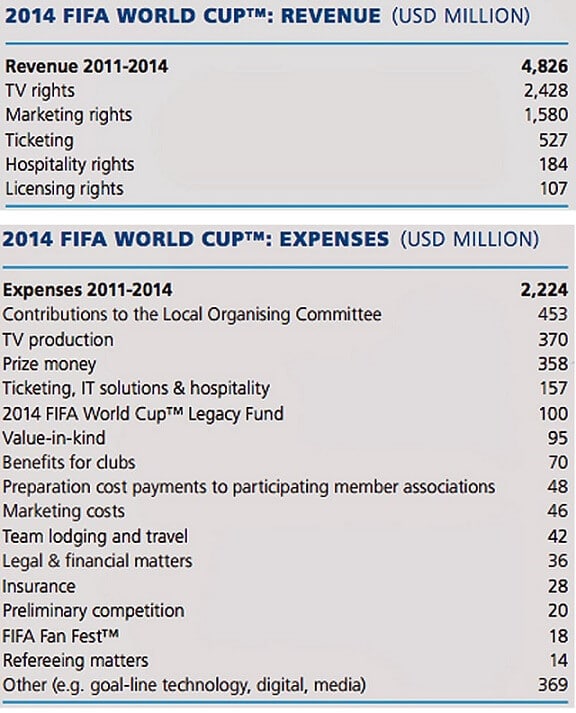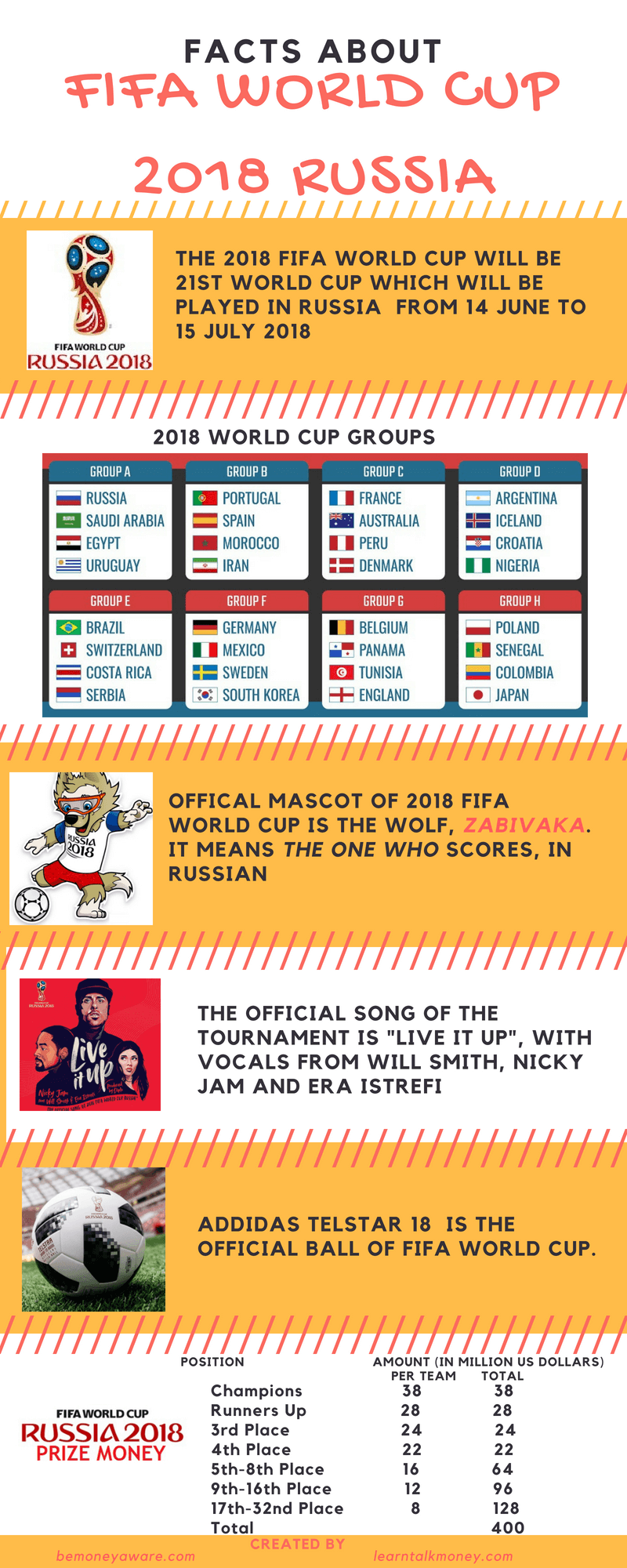The FIFA World Cup 2018, often simply called the World Cup, is an international association football competition contested by the men’s national teams of the members of the Fédération Internationale de Football Association (FIFA). FIFA set to generate $6.1 billion in revenue, 10 per cent more than FIFA had estimated for the tournament and $1.3 billion more than the last World Cup produced in 2014 in Brazil. The 2018 tournament is being held in 11 Russian cities, beginning with 32 teams in a knockout tournament format. The winner will be crowned on 15 July 2018. This article is about Prize Money of FIFA World Cup 2018, Income, Expenses by FIFA and Infographic on facts of FIFA World Cup by us.
Table of Contents
Prize Money for FIFA World Cup 2018
FIFA will make a total payment of USD 657 million for the world cup which is split as given below. The total amount represents an increase of 38% on the USD 476 million paid for the 2014 FIFA World Cup Brazil™. For the prize money, there is a 12 per cent increase on the $358m paid out to teams at the 2014 World Cup in Brazil, where victors Germany received $35m. In 1982, the total prize money was just $20 million. In percentage terms, the largest increase in prize money was in 1990, when it was more than doubled to $54 million.
- $400 million Prize money to the 32 participating members distributed based on performances and finishing position, explained below.
- $48 million as Preparation money for the 32 participating members
- $209 million in Club Benefits Programme for the clubs of participating football players (USD million)
The total prize money for FIFA 2018 is $657 million, of which $400 million will be distributed to the 32 teams based on performances and finishing position as follows
- Ahead of the World Cup, each competing team will be paid $1.5m to cover preparation costs.
- Once in Russia, each of the 32 teams will be guaranteed a participation fee of $8m.
- Progressing through to the first knock-out stage boosts the prize to $9m while a quarter-final finish is worth $14m.
- For the third-place play-off, $42m is shared between the two sides with the victor taking home $22m.
- Runners-up in the final get a $25m prize as the winners enjoy their $38m.
| Finish | 2014 WC prize money | 2018 WC prize money |
|---|---|---|
| Winner | 35 | 38 |
| Runner-up | 25 | 28 |
| 3rd | 22 | 24 |
| 4th | 20 | 22 |
| Quarter-finals | 14 | 16 |
| Last 16 | 9 | 12 |
| Group stage | 8 | 8 |
Club Benefits Programme of FIFA
The FIFA World Cup Club Benefits Programme is designed to recognise the contribution made by football clubs to the success of the FIFA World Cup™. Under the programme, a share of the benefits from the successful hosting of the World Cup is distributed via the member associations to the clubs of the players who participate
in the competition. The share of the benefits of the 2018 FIFA World Cup Russia™ allocated to the Club Benefits Programme is USD 209 million, up by 199% or USD 139 million on the
USD 70 million paid for the 2014 FIFA World Cup Brazil.
FIFA: Income, Expenses
The International Federation of Association Football, Based in Zurich, is the governing body of soccer and organizes many international football tournaments. The association was created in 1904 to provide a single body to oversee soccer. FIFA is designated legally as a nonprofit association, even though it brings in profits upwards of hundreds of millions of dollars each year. FIFA is a non-profit organization that invests most of its earnings back in the development of the game. The earnings come from organizing and marketing major international competitions, with the most popular being the World Cup, which happens every four years. Other competitions like the continental championships and the FIFA Confederations Cup are also quite popular.
Financial reports of FIFA are available on FIFA’s website which you can read here.
The 2018 World Cup is expected to rake in about $6 billion in revenue for FIFA, up 25 per cent from 2014. FIFA made $4.8 billion in revenue from the 2014 World Cup with the profit of $2.6 billion. Broadcast revenue topped $2.43 billion, while sponsorships and ticket sales brought in $1.6 billion and $527 million, respectively.
With as many as 3.2 billion people expected to watch the tournament, broadcast revenue is expected to rise to $3 billion. FIFA continues to face heavy scrutiny as the 2018 World Cup begins, after investigations in 2015 brought forward allegations of corruption and bribery against many of the highest-ranking FIFA officials. Part of the allegations against FIFA include awarding Russia with the 2018 World Cup and Qatar with the 2022 competition. The income and expenses of FIFA for 2014 World Cup in Brazil is shown below. (Ref Business Insider)
FIFA Ticket Sales
FIFA set the 64-game tournament capacity at 2.926 million, with almost 2.6 million tickets available to buy. A week before the opening match of the 2018 FIFA World Cup in Russia, FIFA confirmed that 2,403,116 tickets have been allocated to football fans all around the world since sales started in September 2017. Most of them have gone to Russian fans (871,797), followed by fans from the USA (88,825), Brazil (72,512), Colombia (65,234), Germany (62,541), Mexico (60,302), Argentina (54,031), Peru (43,583), China (40,251), Australia (36,359) and England (32,362) – the top-ten countries from abroad
FIFA Broadcast
The FIFA World Cup is one of the biggest sporting spectacles in the world. Every four years, soccer fans from all around the world rejoice in the thought of an action-packed month of competition culminating in the World Cup final, arguably the biggest game on earth. While the Super Bowl, the biggest game from an American perspective, is viewed by more than a hundred million people in the U.S. plus maybe another 100 across the globe, the 2014 World Cup final between Argentina and Germany had an average in-home TV audience of more than 560 million people. But FIFA is not the biggest sporting event of all in terms of television reach. According to the IOC, the 2012 Olympics in London and the 2008 Olympics in Beijing reached 3.6 and 3.5 billion people in their homes, respectively, edging out the last two World Cups which each attracted 3.2 billion viewers globally.
FIFA requires bids to host the World Cup to include massive tax exemptions for the association. Germany offered FIFA an estimated $272 million in tax exemptions when it hosted the 2006 World Cup, with South Africa and Brazil following suit in 2010 and 2014, respectively. The agreements establish tax-free zones for the World Cup venues, with FIFA’s corporate partners being exempt from income and sales taxes. The nation that hosts the World Cup has its team automatically qualified for the tournament but that status comes with a heavy price on the host nation’s economy.
Construction and preparation for the 2018 World Cup have cost $11.8 billion for Russia. Brazil spent an estimated $15 billion to build stadiums and transportation, among other infrastructure, for the 2014 World Cup. The most expensive of the stadiums, Mane Garrincha Stadium, cost $550 million and only served a handful of events in the months after the tournament — and it is now used a parking lot for buses.
FIFA World Cup 2018 Infographic
Related Articles:
- Cricket:BCCI , BCCI Finances and Lodha Committee
- Sports person income and endorsments : Virat Kohli
- Cricketer and Money
- Is IPL the Indian Premier League the Indian Paisa League?
- Sports as career:So your child wants to be cricketer,badminton player
- What does Bharat Ratna winner get?






Dear Sir,
I was a employee of SIS (I)Ltd from 2007 to 2012. From 2012 to 2018 Pf withdrawal has been submitted 04 times by me, my last form submitted 3rd weak of April 2018, no response got till date. Plz do the needful
Pf No-BR/5020/52221.
EMP Code-PAT-065281.
I wish we could do it.
You can file the complaint How to register EPF complaint at EPF Grievance website online
Or you can do EPF withdrawal offline.
Ugh
hmmm did you like the article or you didn’t?